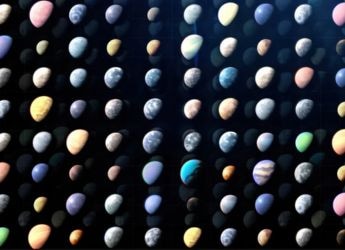- Home
- Science
- Science News
- Scientists Find Out Why Some Distant Planets Have Clouds of Sands in Their Atmosphere
Scientists Find Out Why Some Distant Planets Have Clouds of Sands in Their Atmosphere
The study used observations of brown dwarfs made by NASA’s retired Spitzer Space Telescope.

Photo Credit: NASA/JPL-Caltech
Spitzer telescope spotted traces of silica clouds in the atmosphere of some brown dwarfs
While clouds are made of water on Earth, their composition is quite different on other distant planets. Scientists have noted that some of these planets have sand clouds of silicates but could not unravel the conditions under which they are formed. Now, a new study has revealed the common trait that is conducive to sand cloud development. Led by researchers at the Western University, the study used observations of brown dwarfs made by NASA's retired Spitzer Space Telescope. Brown dwarfs are celestial bodies having size larger than a planet but smaller than a star.
“Understanding the atmospheres of brown dwarfs and planets where silicate clouds can form can also help us understand what we would see in the atmosphere of a planet that's closer in size and temperature to Earth,” said Stanimir Metchev, a professor of exoplanet studies at Western University in London, Ontario, and co-author of the study.
The formation of any type of cloud is the same where the key ingredient gets heated up to form vapours. Once the ingredient — which can be anything from water, salt, sulphur, or ammonia — is trapped and cooled down, clouds are created.
The same principle is involved in the formation of silica clouds but as rock requires a high temperature to vaporise, such clouds are only found on hot celestial bodies like brown dwarfs. Researchers have used incorporated the brown dwarfs in their study as many of them have atmospheres similar to that of gas-dominated planets like Jupiter.
The Spitzer telescope had already spotted traces of silica clouds in the atmosphere of some brown dwarfs. However, the evidence wasn't concrete enough. In the new study, researchers made use of over 100 of the detections and grouped them in accordance with the temperature of the brown dwarf. This helped them unearth a definitive trait and the temperature range in which silica clouds are formed.
“We had to dig through the Spitzer data to find these brown dwarfs where there was some indication of silicate clouds, and we really didn't know what we would find,” said lead author Genaro Suarez.
Get your daily dose of tech news, reviews, and insights, in under 80 characters on Gadgets 360 Turbo. Connect with fellow tech lovers on our Forum. Follow us on X, Facebook, WhatsApp, Threads and Google News for instant updates. Catch all the action on our YouTube channel.
Related Stories
- Samsung Galaxy Unpacked 2025
- ChatGPT
- Redmi Note 14 Pro+
- iPhone 16
- Apple Vision Pro
- Oneplus 12
- OnePlus Nord CE 3 Lite 5G
- iPhone 13
- Xiaomi 14 Pro
- Oppo Find N3
- Tecno Spark Go (2023)
- Realme V30
- Best Phones Under 25000
- Samsung Galaxy S24 Series
- Cryptocurrency
- iQoo 12
- Samsung Galaxy S24 Ultra
- Giottus
- Samsung Galaxy Z Flip 5
- Apple 'Scary Fast'
- Housefull 5
- GoPro Hero 12 Black Review
- Invincible Season 2
- JioGlass
- HD Ready TV
- Laptop Under 50000
- Smartwatch Under 10000
- Latest Mobile Phones
- Compare Phones
- Honor Win RT
- Honor Win
- Xiaomi 17 Ultra Leica Edition
- Xiaomi 17 Ultra
- Huawei Nova 15
- Huawei Nova 15 Pro
- Huawei Nova 15 Ultra
- OnePlus 15R
- Asus ProArt P16
- MacBook Pro 14-inch (M5, 2025)
- OPPO Pad Air 5
- Huawei MatePad 11.5 (2026)
- Xiaomi Watch 5
- Huawei Watch 10th Anniversary Edition
- Acerpure Nitro Z Series 100-inch QLED TV
- Samsung 43 Inch LED Ultra HD (4K) Smart TV (UA43UE81AFULXL)
- Asus ROG Ally
- Nintendo Switch Lite
- Haier 1.6 Ton 5 Star Inverter Split AC (HSU19G-MZAID5BN-INV)
- Haier 1.6 Ton 5 Star Inverter Split AC (HSU19G-MZAIM5BN-INV)

















